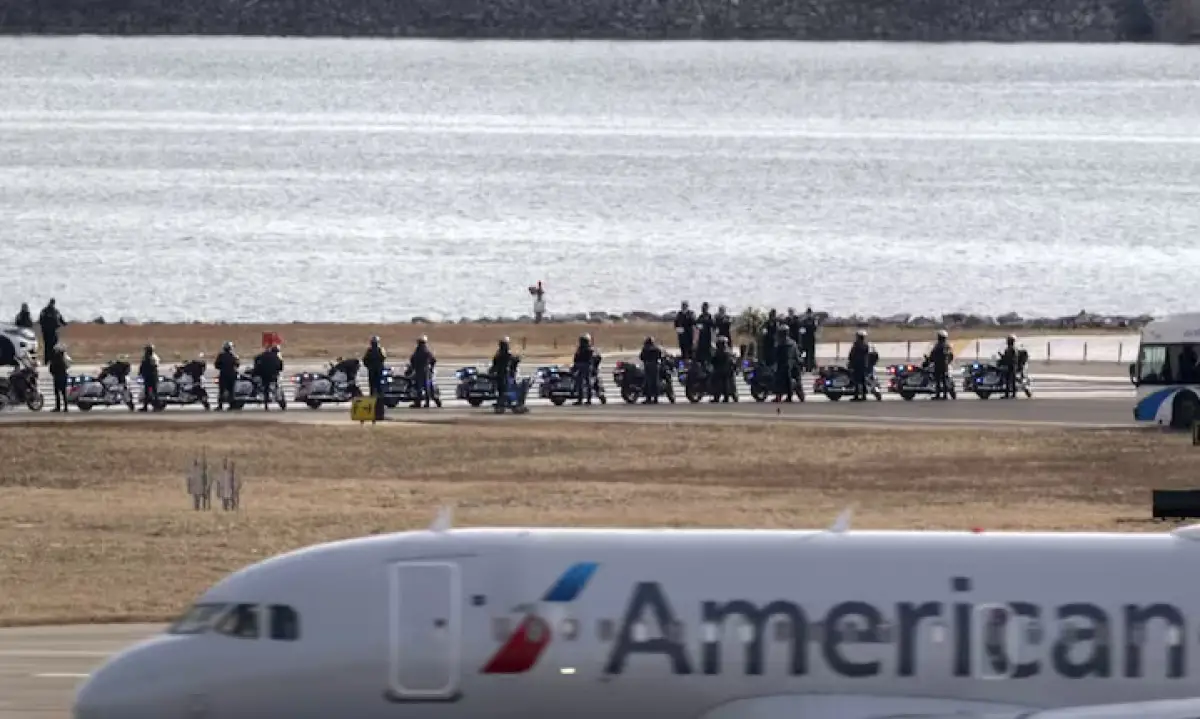This devastating accident occurred at a dangerously low altitude, raising serious concerns about air traffic management, military flight operations, and the safety of both commercial and military aviation. As investigators from the National Transportation Safety Board (NTSB) and Federal Aviation Administration (FAA) work tirelessly to piece together the final moments before the crash, it is clear that this tragedy will have a far-reaching impact on aviation regulations moving forward.
Let’s break down the events leading to the crash, the investigation into the causes, and the emotional aftermath of this calamity.
The Collision: What We Know So Far
On the fateful day, an American Airlines flight, carrying 64 passengers and crew, collided with a US Army Black Hawk helicopter, which was carrying three military personnel. The two aircraft were flying at dangerously low altitudes when they collided, creating a terrifying explosion in the sky. The helicopter was reportedly flying at an altitude of 200 feet, while the American Airlines flight was at 325 feet. This 100-foot altitude discrepancy is one of the key factors under scrutiny by investigators, as it’s highly unusual for two aircraft to be flying at such close altitudes in controlled airspace.
The collision, which occurred over the Potomac River, has raised serious concerns regarding airspace coordination and communication breakdowns between military and civilian aircraft. With no survivors, investigators have a difficult road ahead, as they work to reconstruct the events leading up to the catastrophic impact. However, the recovery of the black box from the American Airlines flight and the ongoing efforts to retrieve the helicopter’s flight recorder from the Potomac River are providing crucial insights into what happened.
The Mysterious Circumstances: Unraveling the Altitude Discrepancy
As of now, the exact cause of the collision remains unclear, but investigators are focusing on several potential factors. One major element is the altitude discrepancy between the two aircraft. Preliminary data shows that the commercial airliner and the Black Hawk were flying at altitudes that were dangerously close to one another. The NTSB and aviation experts are working to understand why both aircraft ended up on a collision course at such low altitudes, especially since the airspace was supposed to be regulated and monitored.
“The altitude records we have so far show a significant discrepancy between the two aircraft, which is highly unusual in controlled airspace,” said an NTSB official. “We need to understand why both aircraft were flying at those levels and whether proper coordination was in place.”
This discrepancy, along with the troubling fact that the two aircraft were not communicating with each other in any meaningful way, has led to questions about air traffic control and whether the proper precautions were taken by both the military and civilian operators. Were there miscommunications in the cockpit? Did either aircraft deviate from their assigned flight paths? These questions remain unanswered, but the black box data is expected to provide some clarity in the coming weeks.
Recovery Efforts: The Challenges of a Difficult Scene
The crash site itself posed significant challenges for recovery teams. The wreckage of the helicopter was scattered across a wide area, and the black box from the Black Hawk helicopter was discovered submerged in the Potomac River. Efforts to retrieve the critical flight data recorder have been complicated by the river’s currents and the difficulty of accessing the wreckage. However, investigators remain determined to recover the black box, which could hold the key to understanding the helicopter’s flight path, communications, and final moments before the collision.
On the other hand, the black box from the American Airlines flight was recovered relatively quickly and is now undergoing a detailed analysis. The data from this flight recorder will likely play a crucial role in piecing together the timeline of events leading to the crash.
Eyewitness Accounts: A Horrifying Scene
Several eyewitnesses reported seeing the two aircraft before they collided, and their accounts paint a harrowing picture of the events that unfolded. Some witnesses near the Potomac River said they saw the Black Hawk helicopter flying lower than usual, which seemed odd to them, especially given the aircraft’s military nature. One witness described hearing a loud explosion before witnessing flames and debris falling from the sky. “We saw the helicopter flying lower than usual, and suddenly, there was this loud explosion,” one onlooker said. “Flames and debris were everywhere.”
Rescue teams responded immediately, but tragically, there were no survivors. Authorities worked throughout the night to recover bodies and secure the wreckage for further investigation. The emotional toll of this crash is immense, as families of the victims are left to mourn their loss, while the investigation seeks answers.
The Aftermath: National and Industry Response
This devastating collision has sent shockwaves through the aviation industry, leading to widespread concern about the safety of airspace management and the need for stricter regulations on military and civilian aircraft operating in close proximity. While the tragedy is still under investigation, the public’s attention has been drawn to the potential gaps in communication between military and civilian operators. The collision has sparked a call for greater oversight and coordination between various sectors of the aviation industry.
“This tragedy highlights the need for a comprehensive review of flight safety protocols, particularly when it comes to military aircraft operating near commercial air routes,” said one aviation analyst.
President Donald Trump, who has made public comments on the crash, has also weighed in on the matter, offering his condolences to the families of the victims and emphasizing the need for the investigation to proceed thoroughly. He has assured the public that his administration will support all efforts to ensure that similar tragedies are prevented in the future.
Moving Forward: A Long Road Ahead
As the NTSB continues its investigation, the families of the victims are demanding answers. The emotional weight of this tragedy is being felt across the nation, and many are questioning whether enough has been done to ensure the safety of both military and civilian aviation. While the recovery of the black boxes offers hope for uncovering the cause of the collision, there is still a long road ahead for investigators.
American Airlines, along with the U.S. Army, has pledged full cooperation with the investigation, and both entities are working diligently to ensure that all relevant information is made available to the public. The ultimate goal is to understand what went wrong and to prevent a similar disaster from happening again.
Conclusion: Learning from Tragedy
As the investigation into this devastating crash continues, one thing is clear: the lessons learned from this tragedy will have far-reaching implications for aviation safety. The questions surrounding the altitude discrepancy, the communication breakdowns, and the safety protocols in place will be critical in shaping future policies and practices in both military and civilian aviation. While the emotional toll of this loss will never fade, it is hoped that the lessons learned from this incident will lead to improved safety measures, ensuring that such a catastrophic event is never repeated.
In the meantime, the focus remains on uncovering the truth behind the crash, supporting the families of the victims, and ensuring that the aviation industry does everything in its power to prevent such a disaster from happening again.

